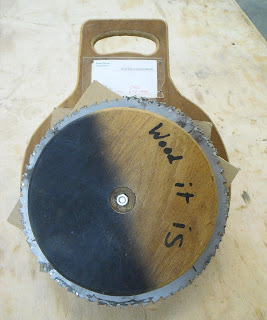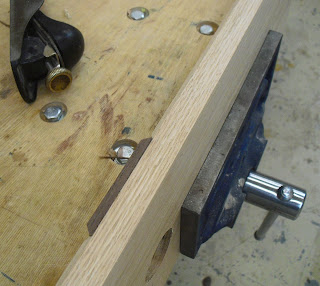This old Makita 2040 planer is my pride and joy.
Oh, she's not so pretty anymore, but damn - she does a hell of a job planing wood. When I graduated from college and hung up my shingle - this was the first big expense for me - nearly 16" of planing power.
There have been literally miles of wood that have passed through this machine. Over time, I tired of sweeping up the piles of sawdust that it made. And I certainly didn't want to buy the dust hood that they made for this - I couldn't afford it. So I made my own out of some HVAC duct parts. It has served me well.
But this machine has been sitting in the corner of my studio for a long time. My 24" Bridgewood planer seems to be the planer of choice, so this smaller one tends to get ignored. The last time we used it, I realized the infeed and outfeed rollers had deteriorated so much, the foam on them was simply falling apart.
Time to pull this apart and give it a little TLC. There are two screws that hold the top in place.
Loosen each one and rotate those little tabs to the side -
and the top plate lifts off - exposing the blades.
Two screws also hold the side cover in place - honestly, this planer is very easy to disassemble.
You're looking at twenty five years of grease and sawdust on that chain.
Here's what needs to be taken out - that orange-colored roller seen from below. .
I took a few pictures of the chain, especially this spring, so that reassembly would be easy.
I've learned that lesson the hard way!
I tried slipping the chain off around the gears but it just wouldn't come out. So the only way to remove the it was by taking out the master link.
While I was reading about this repair, someone online suggested placing a board under the roller, and then lowering the planer head down to the board. That's to support the rollers when they're removed.
All that's left are four screws holding each roller in place. Of course, three of them came out really easily, but the fourth - stuck and rusted in place. So I pulled out my manual impact driver - if you don't own one of these - you have no idea how helpful one can be! When you place its tip in a frozen screw and hit the back of the driver with a hammer, it delivers a strong twisting force to the screw - releasing it. It's perfect for working on old machinery.

All four screws were removed and the rollers were basically free. As I lowered the planer table, each roller dropped down with the piece of wood blocking.
I'm not sure I've ever seen something so funky. Both rollers were misshapen and corroded with years of sawdust embedded in the rubber.
Two options - replace or recover. Luckily, I found a place that would recover each one for about a third of the price of a new one.
I gave them a call - and honestly - the fellow I spoke with was great - he even suggested that since shipping the two rollers was going to be expensive, I could bring them with me to the AWFS wood show coming up here in Vegas in July. He was planning on attending the show, so he could bring my rollers back home in his trailer, thus saving me the shipping.

As I thought about it - I decided the AWFS show was too far away - I didn't want to wait months to get these rollers back into my shop.
As I thought about it - I decided the AWFS show was too far away - I didn't want to wait months to get these rollers back into my shop.
So - I packed the rollers up and shipped them to Oregon today. The next time you see them here - you won't even recognize them!
Next step - changing the blades. Stay tuned!





















































